Just when I was thinking of posting an article about petanque or boules again -- as this is the unltimate French sport for these wonderful long summers' days in the Dordogne, I open the Expatica site to read their news headlines, and notice this article:
11/08/2008 00:00
Local rugby coach Franck Hourcade was bending down to query the score when he received a blow to the head from the heavy metallic ball on Friday.
11 August 2008
LOURDES - A French petanque player died after being struck on the head by a rival's player's ball, near the southwestern Catholic shrine of Lourdes, local gendarmes said Sunday.
Local rugby coach Franck Hourcade was bending down to query the score during the game Friday night when he received a blow to the head from the heavy metallic ball. Seriously injured, he was taken to a hospital in Lourdes where he died shortly afterwards.
The quintessentially French game of petanque, which involves tossing orange-sized metal balls at a little white jack on a dusty court, was invented in the southern French town of La Ciotat a century ago.
Usually associated with old men in berets, fuelled by potent glasses of pastis, the sport has more than half a million registered players in France and a growing following abroad.
[AFP / Expatica]
In a recent article about the game on , the Chateau Lalinde Blog published the following: Learn more about pétanque or boules
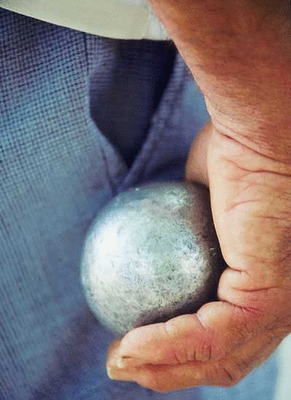 The game of pétanque or boules is truly French, and typifies the easy life in the warm sun, in the dappled shade of the plane trees, with the smell of lavender and the sounds of clanking balls and glasses of pastis in the company of good friends.
The game of pétanque or boules is truly French, and typifies the easy life in the warm sun, in the dappled shade of the plane trees, with the smell of lavender and the sounds of clanking balls and glasses of pastis in the company of good friends. Games with balls, similar to the game of knuckle bones, appear to go back to the dawn of humanity. The first spheres similar to balls and which were probably first used for the hunt, were discovered at Catal Huyuc, an Anatolian town in the Far East, dating back to 5000 BC to 6000 BC.
In Egypt, a game that seems to be the forerunner of pétanque, was called "enkotylé". The object of the game was to knock over a raised stone dioros by using a pebble or a ball. The players decided on the distance between them and the dioros and also on how many throws each one
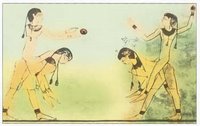 can have to try and knock the stone over. There are Greek statues of men holding two balls in one hand and standing on a circle, exactly as one would do in the game of pétanque, and the Romans, who took many of their games from the Greeks, also depict and write about a game called sphaera or bulla which was played in gymnasiums and was the throwing of balls made from leather and filled with bran, and later with wooden balls. Writers say that the game could be played either standing still or as a running game -- pétanque players and players of Jeu de longue will find some similarity. Another interesting similarity was that the game was also known as buxus or buis, which is that used for box wood. This gives us the names bocce and bocco which are still heard in the Italian and Provençal languages.
can have to try and knock the stone over. There are Greek statues of men holding two balls in one hand and standing on a circle, exactly as one would do in the game of pétanque, and the Romans, who took many of their games from the Greeks, also depict and write about a game called sphaera or bulla which was played in gymnasiums and was the throwing of balls made from leather and filled with bran, and later with wooden balls. Writers say that the game could be played either standing still or as a running game -- pétanque players and players of Jeu de longue will find some similarity. Another interesting similarity was that the game was also known as buxus or buis, which is that used for box wood. This gives us the names bocce and bocco which are still heard in the Italian and Provençal languages.The Gauls easily assimilated the Roman way of life and continued the game of boules. There is ample evidence of boules being played through the ages - and as far back as the 11th Century, whilst the Knights concentrated on tournaments, the feudal peasants became passionately fond of boules. The word "boule" was first mentioned in the 13th Century. In the 16th Century, Rabelais even drew up a complete list in Gargantua of short boules, long boules, flat boules and "boules de butavans" and both Louis XIV and Louis XV were purported to players.
The fact that the aristocracy and ordinary peasants were playing the same games was good for the development of peaceful sports as opposed to the old warlike ones.
England, Spain and the Holy German Empire could not stop the spread of ball games. These were becoming part of the normal amusements.
There are many etchings and paintings of people playing boules during the time of the French Revolution and by all accounts the old soldiers of Napoléon gave themselves up to this devouring passion for sport. The rules of these games were not precisely known. In the 19th Century, the game of boules became incredibly popular and written records bear witness to this. In the second half of this Century , the regional games started to become more organized. This is how the national game took shape in the region of Lyon, while the south of France preferred a more relaxed style adapted to a less rigorous structure.
Pétanque as we know it today was born in 1910 in La Ciotat, near Marseille....
 Apparently -- so the story goes -- but keep in mind that pétanque stories are not much different from fishing stories! it happened that every afternoon boule players met together under the plane trees of the Beraud Club in La Ciotat. They played the Jeu Provençal with their studded boules.
Apparently -- so the story goes -- but keep in mind that pétanque stories are not much different from fishing stories! it happened that every afternoon boule players met together under the plane trees of the Beraud Club in La Ciotat. They played the Jeu Provençal with their studded boules.
Amongst the bystanders who were watching the game seated on chairs, some were unfortunately disturbing it by stopping boules and then causing an argument-- very much a picture one can quite easily visualise if you have spent any time under the plane trees of any little sun drenched French village.......
Anyway, this was apparently why Ernest Pitiot, tired of this situation, decided to remove the chairs --- except for his friend Jules Lenoir's --- whose encroaching chronic rheumatism was preventing him from playing the Jeu Provençal for which he had formerly been so renowned in the area. So the frustrated Jules, unable to join in the competition, started entertaining himself on the side by playing with his own boules in the space left to him -- over only about three metres.
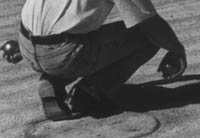 Not to be outdone, his friend Ernest joined in and between them they soon devised a new game which even the handicapped Jules could cope with -- and this, according to the legend, is how these two old friends invented pétanque . The ancient game now newly revised quickly became popular in Provence in spite of the opposition of the traditionalists -- in other words, the Jeu Provençal players and a few years later Ernest Pitiot started the League of Languedoc-Roussillon which led to the founding of the French Federation in 1945. And importantly, this new game was played with "les pieds tanqués" which means "feet tied together" in a throwing circle.Once each team has thrown a boule, those furthest from the jack throw again to try to get the closest. The choice is whether to throw a "pointer" which is an attempt to get closer to the jack, or a "tireur", which is to try to bump the
Not to be outdone, his friend Ernest joined in and between them they soon devised a new game which even the handicapped Jules could cope with -- and this, according to the legend, is how these two old friends invented pétanque . The ancient game now newly revised quickly became popular in Provence in spite of the opposition of the traditionalists -- in other words, the Jeu Provençal players and a few years later Ernest Pitiot started the League of Languedoc-Roussillon which led to the founding of the French Federation in 1945. And importantly, this new game was played with "les pieds tanqués" which means "feet tied together" in a throwing circle.Once each team has thrown a boule, those furthest from the jack throw again to try to get the closest. The choice is whether to throw a "pointer" which is an attempt to get closer to the jack, or a "tireur", which is to try to bump the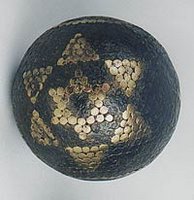

opponents' boule away from the jack. Boules were usually made of boxwood (boxwood was used as the raw material as it has a root shaped like a big ball with knotted fibres that made it highly resistant)and were artistically shaped. Bronze and brass initials, numbers or arabesques were made to decorate or identify them. A skilled worker could not make more than 4 or 5 sets of 2 bowls in a day. According to the area, these designs were squared -- Lyon, curved -- Grenoble or flaked -- Aiguines. In 1923 Vincent Mille and Paul Courtieu invented the bronze bowl, called Intégrale, using the empty charge canon ball technique. But in 1928 Jean Blanc first registered his patent for the boules from "shells" pressed and welded - using the forging principle.
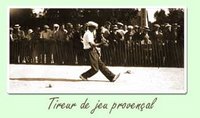 And today, at about 40 km from Saint-Etienne, sitting majestically on the top of a rocky spur of the Monts du Forez, Saint-Bonnet-le-Château has an exceptional panoramic view which goes from the Forez plain to the Massif du Pilat and the Alps. After having acquired a great deal of know-how in the past in the manufacture of locks and arms, this charming little mediaeval town has now become the world capital of pétanque boules. The three largest manufacturers have their factories here, and send about 6 million boules per year to more than 44 countries.
And today, at about 40 km from Saint-Etienne, sitting majestically on the top of a rocky spur of the Monts du Forez, Saint-Bonnet-le-Château has an exceptional panoramic view which goes from the Forez plain to the Massif du Pilat and the Alps. After having acquired a great deal of know-how in the past in the manufacture of locks and arms, this charming little mediaeval town has now become the world capital of pétanque boules. The three largest manufacturers have their factories here, and send about 6 million boules per year to more than 44 countries.The Jack or But --- from the Scandinavian word "butr" which literally means : "little bit of stump", is the smallest part of the game, but the most important -- and probably because of that has a host of names!--- but or jack in English, is the official term used in the official rules, but it also answers to cochon, cochonnet, petit, pitchoune, lé, gamin, gari, maître, gône, biberon, têton, bouchon, lucre, juge, ministre, gendarme.... It is still made of boxwood -- or beech wood, its diameter ranges from 25 to 35 mm -- and if you are lucky -- or clever -- you will have more than one of them in your arsenal -- as no game is possible if you should lose yours! -- and have one in a brightly fluorescent colour as well -- in case the sun sets before the game is over!
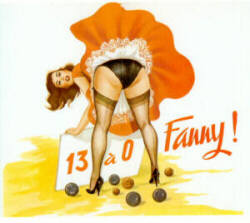 And of course! The history of the world's oldest game would not be complete without La Fanny. If you lose a game of boules by a whopping 13 to 0, you'll have to kiss her -- and rest assured, this is not considered degrading -- La Fanny, the goddess of pétanque, is very much part of the game's cultural heritage -- and some have even been known to lose on purpose in order to perform the forfeit. It is said that the custom started somewhere in Savoie. Fanny was a waitress in a small cafe of Grand-Lemps, and the event happened just before WWI. The story goes that in a game of boules, one of the players did not score a single point. Fanny allowed herself to be kissed by him -- on the cheek of course! This custom continued, until one day, the mayor of the village gained no points and came for his "reward". No one is quite sure whether Fanny simply did not like him or had a grudge against him, but for some reason she took the opportunity to humiliate the man in public, got onto a chair, pulled down her knickers, and offered her lovely little round bottom to the mayor to be kissed. At first the mayor was mortified, but the next thing two loud kisses resounded through the cafe -- and the village -- and the world of pétanque, and a tradition was born! But, of course, Fanny is not always there and available - and willing! So today, the substitute picture or pottery facsimile or wood carving of Fanny's bottom is always available at a pétanque game for the poor soul who loses by 13 to 0!
And of course! The history of the world's oldest game would not be complete without La Fanny. If you lose a game of boules by a whopping 13 to 0, you'll have to kiss her -- and rest assured, this is not considered degrading -- La Fanny, the goddess of pétanque, is very much part of the game's cultural heritage -- and some have even been known to lose on purpose in order to perform the forfeit. It is said that the custom started somewhere in Savoie. Fanny was a waitress in a small cafe of Grand-Lemps, and the event happened just before WWI. The story goes that in a game of boules, one of the players did not score a single point. Fanny allowed herself to be kissed by him -- on the cheek of course! This custom continued, until one day, the mayor of the village gained no points and came for his "reward". No one is quite sure whether Fanny simply did not like him or had a grudge against him, but for some reason she took the opportunity to humiliate the man in public, got onto a chair, pulled down her knickers, and offered her lovely little round bottom to the mayor to be kissed. At first the mayor was mortified, but the next thing two loud kisses resounded through the cafe -- and the village -- and the world of pétanque, and a tradition was born! But, of course, Fanny is not always there and available - and willing! So today, the substitute picture or pottery facsimile or wood carving of Fanny's bottom is always available at a pétanque game for the poor soul who loses by 13 to 0!
Click on Link:
Chateau Lalinde : The perfect venue for your event






